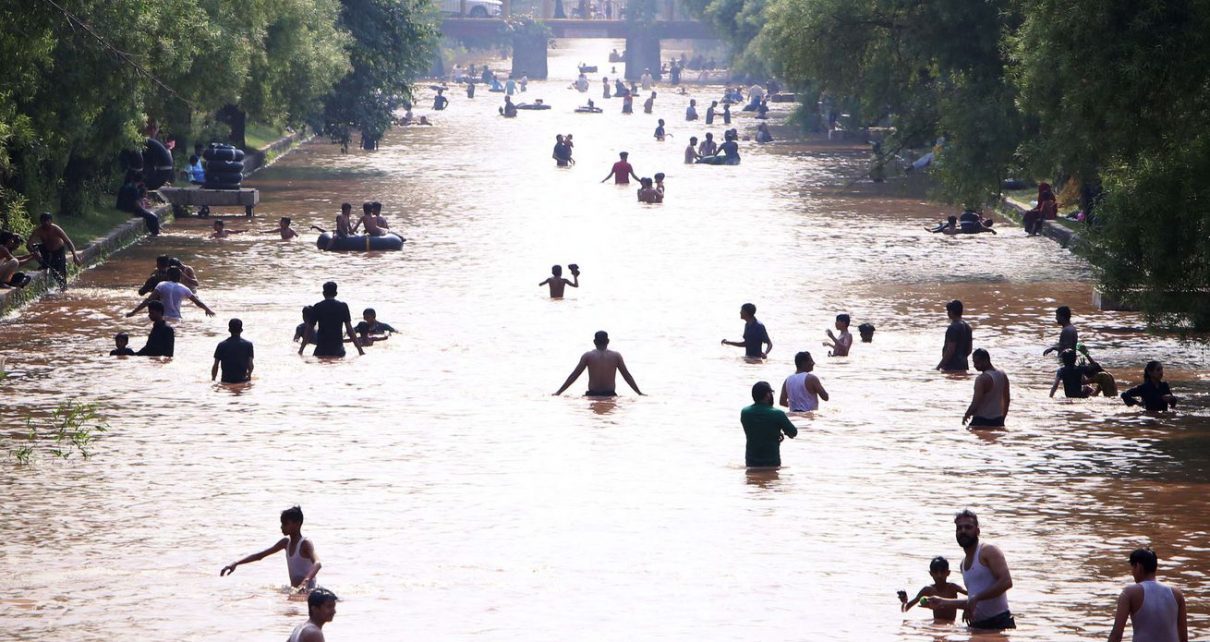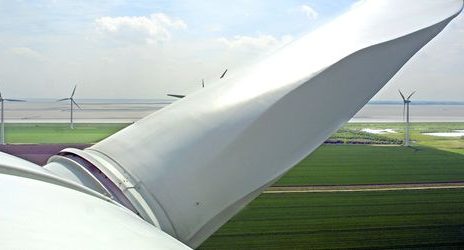
What makes South Asia’s recent severe temperatures so surprising.
Nearly one in eight people on Earth are enduring a relentless, lethal heat wave that is stretching into its third week.
Triple-digit temperatures are continuing to bake swaths of India and Pakistan, a region home to 1.5 billion people. Extreme heat has also scorched Bangladesh and Sri Lanka in recent weeks. For India, this past April was the hottest in 122 years and followed the hottest March on record. For Pakistan, it was the hottest April in 61 years. Jacobabad, Pakistan, already one of the hottest cities in the world, saw temperatures rise above 120 degrees Fahrenheit. Nighttime temperatures are staying in the 90s, granting little relief for the overheated. And more heat is in store for the coming days.
The sweltering weather has reportedly killed at least 25 people in India and 65 people in Pakistan, though the true number of casualties is likely much higher. Even birds are getting heat stroke.
The heat wave has had critical knock-on effects. Surging electricity demand and stress on the power grid triggered power outages for two-thirds of Indian households. Outages in Pakistan have lasted up to 12 hours, cutting off power when people need cooling the most. Without electricity, many households have lost access to water. The hot weather has also increased dust and ozone levels, leading to spikes in air pollution in major cities across the region. The heat melted mountain glaciers faster than normal, triggering flash floods in Pakistan. Ongoing political disruptions and the economic fallout from the Covid-19 pandemic are further hampering the response to the heat wave.
And South Asia’s heat wave is poised to radiate into other countries. The high temperatures are threatening wheat production, which could push already rising food prices even higher around the world.
Harsh heat will build in Southern Asia (again) in the coming days.
Pakistan will break 50°C (122°F) in places. This follows a very hot March and hottest April on record.
The heat really is relentless. Very hot also for large parts of India. pic.twitter.com/LJxFCFEqGL
— Scott Duncan (@ScottDuncanWX) May 8, 2022
India and Pakistan are no strangers to extreme temperatures, but the current heat wave stands out for its early-season timing, its rapid onset, its extent, and its severity. Researchers are now investigating how much human-caused climate change contributed to the severe heat across South Asia. But scientists have long warned that more frequent and more extreme heat waves are some of the most direct consequences of rising global average temperatures.
Climate change is already rendering parts of the world unlivable, and in South Asia, survival now depends on artificial cooling. That cooling demands power. Fans and air conditioners in India and Pakistan run on electricity from burning fossil fuels, which emit greenhouse gases that heat up the planet. About 75 percent of India’s energy comes from coal, oil, and natural gas, while Pakistan gets about 60 percent of its energy from the same mix. The ongoing heat wave has already increased demand for coal imports. How South Asia cools off will shift international energy markets and shape the global climate.
It’s a difficult tension to resolve, trying to mitigate an immediate problem at the risk of worsening another one. It also shows how urgently India and Pakistan need to switch toward cleaner energy sources. But doing so requires political changes that can support the transition without leaving people out to broil.
What made India and Pakistan’s heat wave so surprising
Heat waves are a distinct meteorological phenomenon, in which temperatures rise above the 90th percentile of the average temperature in a given area and stay there for a prolonged period, usually a week or so. Since they’re defined based on a local average, what counts as a heat wave changes depending on the location. The threshold for a heat wave is much higher in India than it is in Canada, for example.
A heat wave begins when a high atmospheric pressure system settles over an area, sometimes triggered by disturbances halfway around the world. The high-pressure system compresses and heats up the air while squeezing out clouds. Without clouds above, sunlight hits the land below directly, stripping away moisture that would otherwise help cool the air. As the pressure builds up, the sun bakes the ground more, and over the course of days, heat accumulates.
South Asia’s heat wave is unusual because it’s happening much earlier in the season than normal, before summer weather typically sets in, so it caught people off guard. It also spread out over a much larger area, covering most of the landmass across Pakistan and India instead of concentrating in a few pockets.
“Ordinarily, there is a slow creeping up [of temperatures] into the summers,” said Suruchi Bhadwal, director for earth science and climate change at the Energy and Resources Institute, who is based in Delhi. “When the temperatures started rising and stayed consistently high, it wasn’t predicted.”
/cdn.vox-cdn.com/uploads/chorus_asset/file/23451565/GettyImages_1215441011t.jpg) Jewel Samad/AFP via Getty Images
Jewel Samad/AFP via Getty ImagesBut with hindsight, researchers said that lower precipitation was one of the key factors in the heat wave. “We had clear weather which caused a lack of rain in March and April,” said Fahad Saeed, a climate scientist at Climate Analytics, based in Islamabad. “The rain was substantially lower than the normal, about 75 percent below normal.”
The recent weather also mirrors what happened in 2021, when temperatures spiked in the months of March and April. “It’s been two years where we are witnessing almost springless seasons,” Saeed said, though he added that it’s too soon to say whether this is a new trend.
A silver lining in the heat wave is that the dry weather has kept humidity low. “I would say the low level of humidity was the reason it was not as fatal as the 2015 heat wave,” Saeed said. During the June 2015 heat wave, which occurred during the monsoon season that brings heavy rains, at least 700 people died in Pakistan and at least 2,300 died in India.
High heat combined with high humidity is a dangerous formula. A key metric for this is wet-bulb temperature, which is the highest temperature under a given amount of humidity where water will not evaporate. It indicates how well a person can cool off by sweating. The maximum wet-bulb temperature an otherwise healthy person can tolerate is about 35 degrees Celsius, or 95 degrees Fahrenheit, for six hours. For people with underlying health conditions, the limit can be much lower.
But South Asia is poised to see more of these dangerous wet-bulb temperatures too. Some places have already reached this 35°C threshold, and the frequency of reaching this limit has doubled since 1979. “That’s one of my biggest concerns: If a high level of mercury [in a thermometer] coincides with a high level of humidity, it can be very fatal,” Saeed said. So far, the seasonal forecast holds that the monsoon season will be drier than normal, but Tropical Cyclone Asani is now barreling toward India’s east coast.
Economic pressures are putting people in harm’s way
The populations of India and Pakistan are especially vulnerable to extreme heat. About 60 percent of India’s workforce and about 40 percent of workers in Pakistan are in agriculture, where the bulk of labor is outdoors. Both countries are currently in their wheat harvest seasons, so millions of people are facing the difficult choice of working during dangerous weather or forgoing their livelihoods.
/cdn.vox-cdn.com/uploads/chorus_asset/file/23451572/GettyImages_1240339580t.jpg) Anindito Mukherjee/Bloomberg via Getty Images
Anindito Mukherjee/Bloomberg via Getty ImagesBut urban areas suffer from extreme heat, too. Teeming metropolises like Mumbai (20 million residents), Delhi (19 million), Karachi (15 million), and Lahore (11 million) heat up faster than their surrounding areas as asphalt, concrete, glass, and steel absorb sunlight.
“The more concretized, high-rise buildings that you have in cities also disrupt open air circulation, the lack of green spaces, and lack of places where people can sit and relax in shade … [they] have their own set of impacts,” Bhadwal said. “That further intensifies the heat conditions in a particular location.”
The worst impacts of extreme heat fall on the most impoverished, in both urban and rural areas, who don’t have access to cooling, shelter, or adequate water. But even people who have fans or air conditioning have to manage their use with power outages and rising energy prices. Many households are only able to cool one or two rooms.
“The moment you move out of the air conditioned space into a space that is not air conditioned, you become highly unproductive. You do not feel like going out and doing anything in that space,” Bhadwal said.
So the full health and economic fallout from the current heat wave will likely take months to determine as researchers tally the number of excess deaths, lost wages, missed school days, and diminished working hours.
Political hurdles continue to thwart action
There are no quick or easy answers to the threat of heat waves. Climate change is a problem more than a century in the making. Restructuring cities and economies to better cope with rising average temperatures is a process that will take decades.
There are ways to protect people in South Asia from heat waves, but it will require leaders in Bangladesh, Sri Lanka, India, and Pakistan to take the problem far more seriously than they have so far. India has committed to zeroing out its contributions to climate change by 2070, a deadline that’s decades after much of the rest of the world. Pakistan has refused to commit to a net-zero target at all.
“Solutions are there, but climate change is not on anyone’s agenda,” said Aseem Prakash, founding director of the Center for Environmental Politics at the University of Washington. “I don’t think any political party is talking about climate change.”
Better urban planning, planting trees, green spaces, improved water infrastructure, pollution controls, and more robust weather forecasting could all help ensure that fewer people suffer as temperatures rise. Switching to cleaner energy sources would also help mitigate the problem over the long term. But leaders in South Asia are more focused on recovering from the Covid-19 pandemic, and some are facing political turmoil. Pakistan ousted its prime minister last month, and Sri Lanka’s prime minister resigned this week.
So at a national level, it’s difficult to get attention on the impacts of climate change and muster the resources needed to prevent it from getting worse. “I don’t think people are going to wake up, because political leaders are framing the issue to score political points,” Prakash said. Much of the action, then, has to happen at local levels, among mayors, governors, and local elected officials who can break down a global problem into its local stakes. “Political entrepreneurship is needed,” Prakash added.
Mitigating and adapting to rising temperatures across South Asia demands international action too. India is now the world’s third-largest greenhouse gas emitter, but the bulk of historical emissions came from wealthier countries like the US and those in Europe. So the countries that contributed most to climate change have an obligation to help those facing the consequences now, as Pakistan’s climate change minister pointed out on Twitter.
At the same time we should remind our developed world friends/govts that it is their pollution we are often paying for. Pakistan’s CO2 emissions r less than 1 % of global emissions. Our commitments to transition r also contingent on pledges made to assist with financing .
— SenatorSherryRehman (@sherryrehman) May 10, 2022
Those wealthy countries, however, have been loath to commit to paying their climate change tab.
Sacrificing climate change commitments for immediate economic or political demands is not unique to South Asia. The US has been pushing for more oil drilling in the wake of Russia’s invasion of Ukraine, for example, despite its own net-zero emissions targets. But the heat wave across India and Pakistan presents a new scale of urgency that these countries face in confronting climate change. How more than 1.5 billion people cope with extreme heat will help determine how much more the planet will warm, and without immediate action to curb emissions and protect the vulnerable around the world, the threat from heat waves will only get worse.
“These incidences are going to increase by the years, and each one of us is going to be facing it in one form or the other,” Bhadwal said.
/cdn.vox-cdn.com/uploads/chorus_asset/file/23451599/GettyImages_1240328148t.jpg) Indranil Aditya/NurPhoto via Getty Images
Indranil Aditya/NurPhoto via Getty Images




